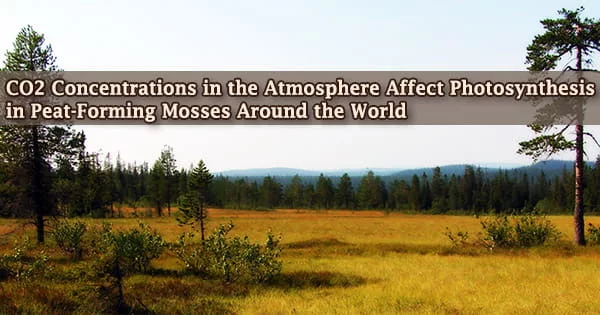Scientists from Umeå University in Sweden and the Swedish University of Agricultural Sciences have devised a method for determining the effects of CO2 rise on metabolic fluxes of major peatland plant species, mosses, over the past 100 years.
Analyses of cellulose in peat cores collected by collaborating scientists from five continents show that a CO2-driven increase in moss photosynthesis is substantially influenced by the water table, potentially changing the species makeup of peat moss communities.
As human CO2 emissions continue, capturing CO2 to counteract climate change becomes increasingly critical. Peatlands are the world’s largest carbon sinks, but the effects of climate change on them are largely unknown.
Global CO2 concentrations in the atmosphere grew by approximately 50% over the twentieth century, and additional increases are unavoidable, according to the Intergovernmental Panel on Climate Change, IPCC, with dire repercussions for civilization. So far, CO2 uptake by the land biosphere has slowed CO2 growth and averted far more severe consequences.
Peatlands store a third of the worldwide soil carbon despite covering only 3% of the global land surface. Thus, while CO2 uptake by peat mosses is crucial, little is known about how rising CO2 levels affect their physiology.
The scientists looked at how peat mosses responded to increased CO2 levels in the atmosphere to see if they could continue to store carbon and counteract climate change in the future.
Peat cores were gathered from ten places throughout the world by collaborating researchers from five continents. The distributions of the stable hydrogen isotope deuterium in the cellulose of modern and century-old peat mosses were then compared using a unique application of nuclear magnetic resonance spectroscopy.
To get a clearer picture of photorespiration’s importance for peat mosses and peat carbon accumulation, the next step is to transfer our data into tailored photosynthesis models to estimate global peatland carbon fluxes. Future CO2 levels, temperature rises, changes in precipitation, and water table levels will all need to be considered to forecast peatlands’ fate in a changing climate.
Jürgen Schleucher
By quantifying the influence of photorespiration, a side reaction of photosynthesis, we were able to recreate variations in photosynthetic efficiency during the twentieth century.
“Photorespiration is critical for the carbon balance of plants because it reduces the efficiency of photosynthesis by up to 35 percent, and it is suppressed by increasing CO2 but accelerated by increasing temperature,” says Jürgen Schleucher, Professor at Department of Medical Biochemistry and Biophysics at Umeå University, Sweden.
According to the study, rising CO2 levels over the previous 100 years have lowered photorespiration, which has likely increased carbon storage in peatlands and slowed climate change.
In peatlands, however, increasing atmospheric CO2 lowered photorespiration only when water levels were intermediate, not when circumstances were extremely wet or dry.
Mosses, unlike higher plants, cannot carry water, therefore their moisture content is controlled by the water table level, which impacts their photosynthetic activity. As a result, models based on the physiological reactions of higher plants cannot be used.
The fact that CO2 has a different effect depending on the water table level can have significant implications for peatland species composition, as only mosses that grow at a medium distance from the water table level benefit from the greater atmospheric CO2 concentration.
Furthermore, changes in the water balance of peatlands can have a significant impact on their future carbon balance, as too wet or too dry circumstances decrease the ability of peat mosses to scavenge carbon. Although peatlands have so far slowed CO2-induced climate change, the changes have already had disastrous consequences.
If human CO2 emissions are not drastically decreased, atmospheric CO2 concentrations will climb by hundreds of parts per million by 2100, and world average temperatures would rise by several degrees Celsius above pre-industrial levels. It’s not clear how this will affect peatlands.
“To get a clearer picture of photorespiration’s importance for peat mosses and peat carbon accumulation, the next step is to transfer our data into tailored photosynthesis models to estimate global peatland carbon fluxes. Future CO2 levels, temperature rises, changes in precipitation, and water table levels will all need to be considered to forecast peatlands’ fate in a changing climate,” says Jürgen Schleucher.





